SOHC carburation and setting up
-
James Bowen
- Posts: 90
- Joined: June 23rd, 2006, 8:17 pm
- Location: Brighton, UK.
- Contact:
-
Guy Croft
- Site Admin
- Posts: 5039
- Joined: June 18th, 2006, 9:31 am
- Location: Bedford, UK
- Contact:
Ok, good.
I had indicated earlier that I would be using something like:
Main Jet 125
Air corrector 170-180
Idle - 45
Pump - 45
Your super-rich 130 a/c tube now has_to_ go. Whatever the optimised jetting turns out to be, there is no way an a/c smaller than main jet is going to be right. Whoever fitted or fit-for-duty approved them, don't go back there!
The combination of rich F24 tube and 125 main should be good. Now is the time to get rid of the over-rich air correctors and get into the 170 plus range in there. Leave the main jets alone for now. You'd be wasting your time doing any other road testing till you've done this.
I have to say again at this juncture that if this combo doesn't 'light up' you really should get the head/inlet/cam to me for my detailed evaluation. I don't know these 'Cat Cams' at all and never use them, and I don't know the characteristics of your head at all. Cams and heads go, well, together really. I can explain more if I have to, but hopefully I won't need to.
GC
I had indicated earlier that I would be using something like:
Main Jet 125
Air corrector 170-180
Idle - 45
Pump - 45
Your super-rich 130 a/c tube now has_to_ go. Whatever the optimised jetting turns out to be, there is no way an a/c smaller than main jet is going to be right. Whoever fitted or fit-for-duty approved them, don't go back there!
The combination of rich F24 tube and 125 main should be good. Now is the time to get rid of the over-rich air correctors and get into the 170 plus range in there. Leave the main jets alone for now. You'd be wasting your time doing any other road testing till you've done this.
I have to say again at this juncture that if this combo doesn't 'light up' you really should get the head/inlet/cam to me for my detailed evaluation. I don't know these 'Cat Cams' at all and never use them, and I don't know the characteristics of your head at all. Cams and heads go, well, together really. I can explain more if I have to, but hopefully I won't need to.
GC
-
James Bowen
- Posts: 90
- Joined: June 23rd, 2006, 8:17 pm
- Location: Brighton, UK.
- Contact:
-
James Bowen
- Posts: 90
- Joined: June 23rd, 2006, 8:17 pm
- Location: Brighton, UK.
- Contact:
170 A/C 's installed.
Engine pulls cleanly to 7,300 - 7,500..... though acceleration slowing after 7,000.
Feels more "perky and revy" than when using the 130 A/C's.
Spark plug check after several full throttle runs, and minimal coast down. Light grey deposits on insulator nose, and seat area. (previously seat area was sooty black but not thickly coated) Electrode appears clean, with no soot, and some tiny light grey deposits.
Seems that it may be running a tad too lean to me. (?)
Comments welcome.
Regards, James
Engine pulls cleanly to 7,300 - 7,500..... though acceleration slowing after 7,000.
Feels more "perky and revy" than when using the 130 A/C's.
Spark plug check after several full throttle runs, and minimal coast down. Light grey deposits on insulator nose, and seat area. (previously seat area was sooty black but not thickly coated) Electrode appears clean, with no soot, and some tiny light grey deposits.
Seems that it may be running a tad too lean to me. (?)
Comments welcome.
Regards, James
-
Guy Croft
- Site Admin
- Posts: 5039
- Joined: June 18th, 2006, 9:31 am
- Location: Bedford, UK
- Contact:
Looking good now then, acceleration slowing could be the small choke size, cannot breathe enough for that cam maybe.
Plug sounds about the right shade though. Pale grey (correct) to light brown (bit richer) is what you should be looking for on the steel outer section of the plug, insulator nose pale yellow. Absence of tiny flecks of aluminium shining on electrode generally means no detonation.
So your 40 DCNFs are now jetted:
Mains 125
A/C 170
Emulsion tubes F24
Chokes 32
Why not avail yourself of a really good session with Troy and Steve at Northampton Motorsport? They are a clued-up-top-notch RR team, Weber dealers too - so no shortage of jets. 01604 766624 (See links).
Sure, you can certainly enrich - I would do this via main jet first, go just one size bigger to 130 and see what happens. May not sound much but a 130 will flow 8% more fuel than a 125. That will enrich from about 3500 right up to top end. If that works - go next size up - stop and go back to previous if no gain. That's how jetting is refined. Trouble is the engine may need a richer main jet and a leaner (bigger) air corector - to enrich the mid range without making the top-end too rich.
You can get in a real mess without a dyno to prove it out. If you follow my drift...
Well done you, anyhow, you have provided some really 'text-book' feedback here, thanks.
GC
Plug sounds about the right shade though. Pale grey (correct) to light brown (bit richer) is what you should be looking for on the steel outer section of the plug, insulator nose pale yellow. Absence of tiny flecks of aluminium shining on electrode generally means no detonation.
So your 40 DCNFs are now jetted:
Mains 125
A/C 170
Emulsion tubes F24
Chokes 32
Why not avail yourself of a really good session with Troy and Steve at Northampton Motorsport? They are a clued-up-top-notch RR team, Weber dealers too - so no shortage of jets. 01604 766624 (See links).
Sure, you can certainly enrich - I would do this via main jet first, go just one size bigger to 130 and see what happens. May not sound much but a 130 will flow 8% more fuel than a 125. That will enrich from about 3500 right up to top end. If that works - go next size up - stop and go back to previous if no gain. That's how jetting is refined. Trouble is the engine may need a richer main jet and a leaner (bigger) air corector - to enrich the mid range without making the top-end too rich.
You can get in a real mess without a dyno to prove it out. If you follow my drift...
Well done you, anyhow, you have provided some really 'text-book' feedback here, thanks.
GC
Last edited by Guy Croft on February 21st, 2007, 3:18 pm, edited 1 time in total.
-
James Bowen
- Posts: 90
- Joined: June 23rd, 2006, 8:17 pm
- Location: Brighton, UK.
- Contact:
The thread started off about comparing Side and Downdraught carbs. Now I have firm base to make that comparison myself, when I look again at fitting them. Rolling Road session is on the cards sometime soonish. I'll certainly consider Northampton Motorsport. Though no stain on any other company I've mentioned using on this thread. They did their best with what they had to work with from me, and to their credit they did say the carb settings were not what they would want or should be.....
Thank you both for your comments.....but really all the thanks to Guy for spending the time and effort to educate and show the reasons behind building and setting up engines properly.
Regards,
James
Thank you both for your comments.....but really all the thanks to Guy for spending the time and effort to educate and show the reasons behind building and setting up engines properly.
Regards,
James
-
Westfield
- Posts: 42
- Joined: July 14th, 2006, 11:41 pm
- Location: Dublin Ireland
- Contact:
What is a windage tray and what dose it do? It looks like it goes in the sump?James Bowen wrote:Kev.
Thanks for that. Thats something that I wouldn't have considered. The fuel pump is a Facet silver top, so should be OK. Though maybe not?
Acki,
Its a windage tray, bought from the same company.
Regards
James
Gary
Thank you
-
James Bowen
- Posts: 90
- Joined: June 23rd, 2006, 8:17 pm
- Location: Brighton, UK.
- Contact:
I could not honestly give a good answer to that despite actually buying and fitting one. Over to Guy, or someone else who knows.
By the way, for info I tried the 130 main jets. I didn't change the air correctors from 170's. (All tests done at WOT) I found the engine wouldn't take full throttle before 3,000rpm, bogged a bit until 4,500rpm, then was about the same as the 125 main jets from there on up the rev range. So conclusions drawn are that Mid range is too rich with 130 main. I have changed back to 125 mains, and will stick with them.
Attached are some pictures of the revised exhaust manifold, and system.
I don't know what power I have currently got, but acceleration is clean and pretty rapid till around 100mph.
Regards, James
By the way, for info I tried the 130 main jets. I didn't change the air correctors from 170's. (All tests done at WOT) I found the engine wouldn't take full throttle before 3,000rpm, bogged a bit until 4,500rpm, then was about the same as the 125 main jets from there on up the rev range. So conclusions drawn are that Mid range is too rich with 130 main. I have changed back to 125 mains, and will stick with them.
Attached are some pictures of the revised exhaust manifold, and system.
I don't know what power I have currently got, but acceleration is clean and pretty rapid till around 100mph.
Regards, James
- Attachments
-
- X1/9 purests look away. Rear valance cut away to fit new pipe run.
- Rear.jpg (39.05 KiB) Viewed 9952 times
-
- Mounting bracket altered.
- Box.jpg (43.49 KiB) Viewed 9953 times
-
- View of the extended section of manifold. The collector was cut off, 7" straight tubes welded on, then collector replaced. The two daubs of sealing putty are a result of my almost perfect welding.
- Extentions.jpg (40.33 KiB) Viewed 9954 times
-
James Bowen
- Posts: 90
- Joined: June 23rd, 2006, 8:17 pm
- Location: Brighton, UK.
- Contact:
Hello,
I've dragged this topic back as I have now fitted larger 34mm chokes replacing the 32mm chokes I had before.
Jetting is now...;
Mains - 130
A/C's - 170
Emulsion tubes - F24
Chokes - 34mm
Pump Jet - 50
Idle Jet - 50
I have run this set up for a couple of months, but been unable to give a reasonably complete evaluation till now. I have still not put the car on a Rolling Road. But I have been able to check the fuelling via a Lambda sensor. The results are described below;
The induction resonance has increased again slightly and moved up the rpm range to 2,900rpm till 3,400rpm. I presume this is because the larger chokes mean a lower air speed through the carb. at a given rpm.
The torque seems to come in more progressively (Than before I started the whole process described in this thread) The engine pulls from 3,500 rpm till peaking at around 5,500 rpm and seems to hold till near 7,000rpm dropping slightly till 7,400rpm, then dropping off.
I saw Peter's comments in Damirgti's thread on setting up a Peugeot 205 engine.
The results are;
4,000rpm 0.92v
4,500rpm 0.86v
5,000rpm 0.85v
5,500prm 0.81v - 0.82v
6,000rpm 0.85v
6,500rpm till
7,500rpm 0.84v
This was done at WOT in both 3rd and 4th gears (till 6,000 in 4th as were getting on for some speed then!)
As you can see, its quite rich through 4,000 rpm at about 4,500 rpm the mixture is good. It goes a trifle lean at around peak torque 5,500 rpm, but then settles to between 0.84 - 0.85volts right up to 7,500rpm. I reckon this is pretty good for a carburettor fuelled car.
I have noted that part throttle acceleration throughout the rev range is good as well. Voltages from 0.84 to 0.88 volts at any point in the part throttle acceleration range, from progression stage through to 5,000rpm plus.
I still need to check these results on a Rolling Road, and a power figure would be good. But I am happy that the car pulls better, (more torque) and higher in the rev range (more power) than before the start of this topic. I think circa 110 lbs, and 130+bhp are realistic. Many thanks Guy!
Regards, James
I've dragged this topic back as I have now fitted larger 34mm chokes replacing the 32mm chokes I had before.
Jetting is now...;
Mains - 130
A/C's - 170
Emulsion tubes - F24
Chokes - 34mm
Pump Jet - 50
Idle Jet - 50
I have run this set up for a couple of months, but been unable to give a reasonably complete evaluation till now. I have still not put the car on a Rolling Road. But I have been able to check the fuelling via a Lambda sensor. The results are described below;
The induction resonance has increased again slightly and moved up the rpm range to 2,900rpm till 3,400rpm. I presume this is because the larger chokes mean a lower air speed through the carb. at a given rpm.
The torque seems to come in more progressively (Than before I started the whole process described in this thread) The engine pulls from 3,500 rpm till peaking at around 5,500 rpm and seems to hold till near 7,000rpm dropping slightly till 7,400rpm, then dropping off.
I saw Peter's comments in Damirgti's thread on setting up a Peugeot 205 engine.
I decided I'd have a go at checking my fuelling via a Lambda sensor myself.AFR's
I have both wide and narrow band sensors to check AFR's. Stoichmetric, 14.7:1 is equal to 0.638V on a typical narrow band sensor, not 0.5V. I have cross checked voltages against an M&W Uego and Haltech Uego and found the following of typical NTK and Bosch narrow band sensors.
0.78V - 13.5:1
0.82V - 13:1
0.85V - 12.7:1
The results are;
4,000rpm 0.92v
4,500rpm 0.86v
5,000rpm 0.85v
5,500prm 0.81v - 0.82v
6,000rpm 0.85v
6,500rpm till
7,500rpm 0.84v
This was done at WOT in both 3rd and 4th gears (till 6,000 in 4th as were getting on for some speed then!)
As you can see, its quite rich through 4,000 rpm at about 4,500 rpm the mixture is good. It goes a trifle lean at around peak torque 5,500 rpm, but then settles to between 0.84 - 0.85volts right up to 7,500rpm. I reckon this is pretty good for a carburettor fuelled car.
I have noted that part throttle acceleration throughout the rev range is good as well. Voltages from 0.84 to 0.88 volts at any point in the part throttle acceleration range, from progression stage through to 5,000rpm plus.
I still need to check these results on a Rolling Road, and a power figure would be good. But I am happy that the car pulls better, (more torque) and higher in the rev range (more power) than before the start of this topic. I think circa 110 lbs, and 130+bhp are realistic. Many thanks Guy!
Regards, James
-
Westfield
- Posts: 42
- Joined: July 14th, 2006, 11:41 pm
- Location: Dublin Ireland
- Contact:
-
Guy Croft
- Site Admin
- Posts: 5039
- Joined: June 18th, 2006, 9:31 am
- Location: Bedford, UK
- Contact:
Re: SOHC carburation and setting up
So many have read this thread, James, I just wanted to ask if you'd have a rolling-road follow-up yet?
GC
GC
-
James Bowen
- Posts: 90
- Joined: June 23rd, 2006, 8:17 pm
- Location: Brighton, UK.
- Contact:
Re: SOHC carburation and setting up
Guy,
Thanks for the interest... I have to confess that no I have not. The engine and induction has been behaving well, only needing a slight tinker to re-balance the carbs. Otherwise I have rather neglected the pursuit for more power, as we have had another daughter to contend with...
I was planning to run it to Track 'n Road in Essex for a power run and fuelling check sometime in the next couple of months, before I do some Sprints and maybe a track day or two this summer.
Just for interest I have included a picture below of the car ( and me ) at the Brighton Speed Trials 2007. I recorded a 15.97 sec 1/4 mile, which included a fluffed gear change 3rd to 4th and a 10mph lower finish speed than the previous run... so maybe a 15.5 may be on the cards this year? I'd be pleased with that....
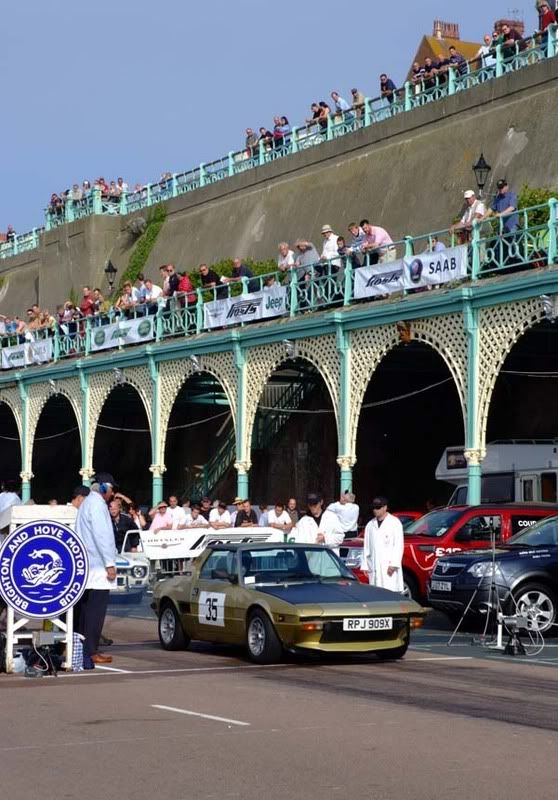
Regards, James
Thanks for the interest... I have to confess that no I have not. The engine and induction has been behaving well, only needing a slight tinker to re-balance the carbs. Otherwise I have rather neglected the pursuit for more power, as we have had another daughter to contend with...
I was planning to run it to Track 'n Road in Essex for a power run and fuelling check sometime in the next couple of months, before I do some Sprints and maybe a track day or two this summer.
Just for interest I have included a picture below of the car ( and me ) at the Brighton Speed Trials 2007. I recorded a 15.97 sec 1/4 mile, which included a fluffed gear change 3rd to 4th and a 10mph lower finish speed than the previous run... so maybe a 15.5 may be on the cards this year? I'd be pleased with that....

Regards, James
-
James Bowen
- Posts: 90
- Joined: June 23rd, 2006, 8:17 pm
- Location: Brighton, UK.
- Contact:
Re: SOHC carburation and setting up
Hello Guy,
As you prompted me last week, I felt that I should get the X1/9 properly rolling roaded, if only to check that fuelling was correct. But I also wanted to get an idea of power and torque, and to gauge improvements.
To summerise the engine, after 1.) Setting the cam timing correctly to straight up / split overlap
2.) Changing the exhaust silencer to a George Polly type…….
I had really not improved matters on the jetting of the carbs. I then…..
3.) Lengthened the exhaust primary tubes from 23” to 30”
This seemed to get an immediate improvement, by moving the “resonance” in the induction down the rev range by about 1,000 rpm. I felt that the car was able to take the bigger air corrector that we had been trying to use, and that fuelling was better with the car more willing to rev. I then
4.) Opened out the chokes from 32mm to 34mm.
The resonance moved back up the rev range about 300 rpm, but the engine felt more willing to rev higher. i.e. it felt that it was still producing power higher in the rev range.
I checked fuelling with a lambda sensor and multi-meter, and reckoned that it was fine all through the range, on part throttle and full. WRONG
OK, the company I used is local to me, and mainly chosen due to me thinking I had the fuelling correct already, and I only wanted a power run / fuelling check. Happily the operator Paul says he learnt to jet carburettors directly from a certain Mr Vizard.
As a reminder the carb settings were;
Mains - 130
A/C's - 170
Emulsion tubes - F24
Chokes - 34mm
Pump Jet - 50
Idle Jet - 50
Well the initial run up was disappointing. The car had felt really good on the road, but the figures told a different story. Fuelling was very rich at part throttle, and mid range, and still rich at top end at full throttle.
We swopped to a 200 air corrector which immediately saw that part throttle was good, but the mix was lean throughout full throttle, especially above 5,000rpm.
The end jetting which is spot on between 5,000 rpm till 7,500 rpm is :-
Mains - 140
A/C's - 200
Emulsion tubes - F24
Chokes - 34mm
Pump Jet - 50
Idle Jet - 50
But…Mid range till 5,000 rpm (full throttle) has been richened to 11.6:1 AFR. Part throttle seems OK
Several issues identified by Guy still persist. There are several other points to mention….
1.) Despite very different jetting, the original rich mid range / leaner (correct) top end compromise still exists
2.) The engine was almost as sensitive to change of air corrector in the mid range 3,000 till 5,000 rpms as the higher ranges, despite “Classic” advice to the contary (Weber tuning manual for example)
3.) Whilst the headline power figure is still around the same as when I started out, the overall area under the torque curve is less, due to the torque coming up later
4.) There is a big dip in the torque curve from 4,000 rpm till 5,000 rpm that was ‘hardly’ present before
5.) Bigger chokes ‘feel’ that they have made a difference (better) to top end breathing, but the figures say otherwise
So conclusions….
Well Guy is the expert and I’m hazarding guesses here, (though educated by this site guesses)
1.) The cylinder head is not flowing enough air for the cam i.e. The reason the torque curve is essentially flat, is that at about 5,000 rpm the head is flowing all it can, where as the cam, working with the exhaust and induction wants to shift more air through the valves. There are several pieces of work that Guy has produced and posted, and other threads that have appeared on this site since I built my engine. As a point of reference, my ports are 28.5 mm wide by 25mm tall at the narrowest point. The Big valve head prepared for Dr McMullen by Guy has 31.5mm by 30mm I believe. Also advice to Andy was to make the ports parallel to 33mm.
2.) Although just looking at the power /torque curves, some may say that the engine is now less powerful, and the previous measures haven’t worked, I’d dispute that, and say that the fact that the ‘resonance’ now occurs at lower rpms and that the torque comes on more progressively, and that I have a decent size air corrector all show that the exhaust was a culprit, but just not the only one?
Guy, I know that you have said in previous posts that if the measures taken didn’t work, then I needed to get the head and cam up to you for evaluation. Unfortuately I need that car to get to work on the odd occasion, so this isn’t possible at the moment. But as always your comments and any advice are greatly appreciated.
Regards, James
As you prompted me last week, I felt that I should get the X1/9 properly rolling roaded, if only to check that fuelling was correct. But I also wanted to get an idea of power and torque, and to gauge improvements.
To summerise the engine, after 1.) Setting the cam timing correctly to straight up / split overlap
2.) Changing the exhaust silencer to a George Polly type…….
I had really not improved matters on the jetting of the carbs. I then…..
3.) Lengthened the exhaust primary tubes from 23” to 30”
This seemed to get an immediate improvement, by moving the “resonance” in the induction down the rev range by about 1,000 rpm. I felt that the car was able to take the bigger air corrector that we had been trying to use, and that fuelling was better with the car more willing to rev. I then
4.) Opened out the chokes from 32mm to 34mm.
The resonance moved back up the rev range about 300 rpm, but the engine felt more willing to rev higher. i.e. it felt that it was still producing power higher in the rev range.
I checked fuelling with a lambda sensor and multi-meter, and reckoned that it was fine all through the range, on part throttle and full. WRONG
OK, the company I used is local to me, and mainly chosen due to me thinking I had the fuelling correct already, and I only wanted a power run / fuelling check. Happily the operator Paul says he learnt to jet carburettors directly from a certain Mr Vizard.
As a reminder the carb settings were;
Mains - 130
A/C's - 170
Emulsion tubes - F24
Chokes - 34mm
Pump Jet - 50
Idle Jet - 50
Well the initial run up was disappointing. The car had felt really good on the road, but the figures told a different story. Fuelling was very rich at part throttle, and mid range, and still rich at top end at full throttle.
We swopped to a 200 air corrector which immediately saw that part throttle was good, but the mix was lean throughout full throttle, especially above 5,000rpm.
The end jetting which is spot on between 5,000 rpm till 7,500 rpm is :-
Mains - 140
A/C's - 200
Emulsion tubes - F24
Chokes - 34mm
Pump Jet - 50
Idle Jet - 50
But…Mid range till 5,000 rpm (full throttle) has been richened to 11.6:1 AFR. Part throttle seems OK
Several issues identified by Guy still persist. There are several other points to mention….
1.) Despite very different jetting, the original rich mid range / leaner (correct) top end compromise still exists
2.) The engine was almost as sensitive to change of air corrector in the mid range 3,000 till 5,000 rpms as the higher ranges, despite “Classic” advice to the contary (Weber tuning manual for example)
3.) Whilst the headline power figure is still around the same as when I started out, the overall area under the torque curve is less, due to the torque coming up later
4.) There is a big dip in the torque curve from 4,000 rpm till 5,000 rpm that was ‘hardly’ present before
5.) Bigger chokes ‘feel’ that they have made a difference (better) to top end breathing, but the figures say otherwise
So conclusions….
Well Guy is the expert and I’m hazarding guesses here, (though educated by this site guesses)
1.) The cylinder head is not flowing enough air for the cam i.e. The reason the torque curve is essentially flat, is that at about 5,000 rpm the head is flowing all it can, where as the cam, working with the exhaust and induction wants to shift more air through the valves. There are several pieces of work that Guy has produced and posted, and other threads that have appeared on this site since I built my engine. As a point of reference, my ports are 28.5 mm wide by 25mm tall at the narrowest point. The Big valve head prepared for Dr McMullen by Guy has 31.5mm by 30mm I believe. Also advice to Andy was to make the ports parallel to 33mm.
2.) Although just looking at the power /torque curves, some may say that the engine is now less powerful, and the previous measures haven’t worked, I’d dispute that, and say that the fact that the ‘resonance’ now occurs at lower rpms and that the torque comes on more progressively, and that I have a decent size air corrector all show that the exhaust was a culprit, but just not the only one?
Guy, I know that you have said in previous posts that if the measures taken didn’t work, then I needed to get the head and cam up to you for evaluation. Unfortuately I need that car to get to work on the odd occasion, so this isn’t possible at the moment. But as always your comments and any advice are greatly appreciated.
Regards, James
-
Guy Croft
- Site Admin
- Posts: 5039
- Joined: June 18th, 2006, 9:31 am
- Location: Bedford, UK
- Contact:
Re: SOHC carburation and setting up
James, hi
I cannot read the power curve very well, can u email a clear copy to croftengines@aol.com
I hope the RR did a before/after rejet test? I'm not arguing on this site with rolling roads but I cannot say I like the look of that jetting, 140 is a big main jet on that engine. If I can't have before-after curves I might be a bit lost, frankly.
It is quite possible the head and/or cam may be to blame, sure, it is so easy to mask a problem there with, er 'jetting'.
Gc
I cannot read the power curve very well, can u email a clear copy to croftengines@aol.com
I hope the RR did a before/after rejet test? I'm not arguing on this site with rolling roads but I cannot say I like the look of that jetting, 140 is a big main jet on that engine. If I can't have before-after curves I might be a bit lost, frankly.
It is quite possible the head and/or cam may be to blame, sure, it is so easy to mask a problem there with, er 'jetting'.
Gc
-
Abarthnorway - Remi L
- Posts: 207
- Joined: June 24th, 2006, 1:39 pm
- Location: Oslo, Norway
- Contact:
Re: SOHC carburation and setting up
Hi James!
First good luck on Your continuous development of Your engine!
Regarding the port sizes I think 25 x 28.5 mm inlet port might be a bit small for the 1500 engine with that cam. Although going very much larger seems weird as the valve throat is only 30 mm. A +30mm on a 30 valve throat and 36 mm valve sounds like a bad idea in my opinion. 28 - 29 seems more right if coupled with increased valve throat diameter.
For detailed information look at the thread:
phpBB3/viewtopic.php?f=13&t=1285
Here is a 1290 head I prepare for a friend:

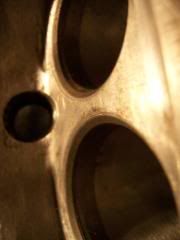
Valve throat enlarged to 32.5 mm, valve seats with 70`, 45` , and a deep 30 top cut into the aluminium.
Problem with the seats were that the seat inserts were marginal for the valves. I had to turn down the inlets from 36.2 to 36mm and from 32 to 31.5 mm on exhaust..... and I still have only 0.25 mm of 30`seat before entering into the combustion chamber aluminium. Valves now dropped nearly 2 mm deeper in head....
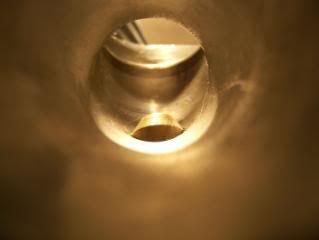
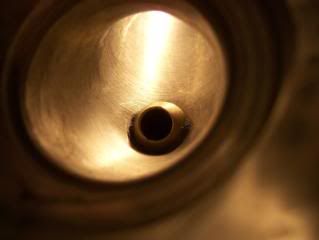
Look down inlet port tapering from 32 at face to 28.5 x 28.5 at narrowest just before valve guide - Material taken from roof & sides only. Note the slight offset of the port in relation to the valve guide - a result of 8 ports on one side of the head......
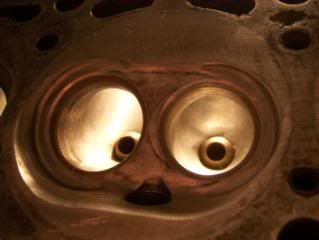
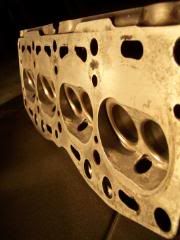
Some lightly opened up combustion chambers.
More on the engine and car in thread: phpBB3/viewtopic.php?f=5&t=1382
Best regards
Remi Lovhoiden
First good luck on Your continuous development of Your engine!
Regarding the port sizes I think 25 x 28.5 mm inlet port might be a bit small for the 1500 engine with that cam. Although going very much larger seems weird as the valve throat is only 30 mm. A +30mm on a 30 valve throat and 36 mm valve sounds like a bad idea in my opinion. 28 - 29 seems more right if coupled with increased valve throat diameter.
For detailed information look at the thread:
phpBB3/viewtopic.php?f=13&t=1285
Here is a 1290 head I prepare for a friend:


Valve throat enlarged to 32.5 mm, valve seats with 70`, 45` , and a deep 30 top cut into the aluminium.
Problem with the seats were that the seat inserts were marginal for the valves. I had to turn down the inlets from 36.2 to 36mm and from 32 to 31.5 mm on exhaust..... and I still have only 0.25 mm of 30`seat before entering into the combustion chamber aluminium. Valves now dropped nearly 2 mm deeper in head....


Look down inlet port tapering from 32 at face to 28.5 x 28.5 at narrowest just before valve guide - Material taken from roof & sides only. Note the slight offset of the port in relation to the valve guide - a result of 8 ports on one side of the head......


Some lightly opened up combustion chambers.
More on the engine and car in thread: phpBB3/viewtopic.php?f=5&t=1382
Best regards
Remi Lovhoiden
GC_45
Who is online
Users browsing this forum: No registered users and 67 guests